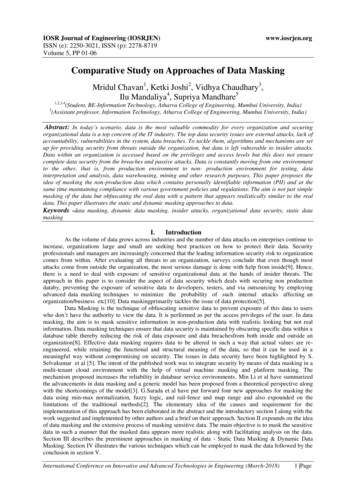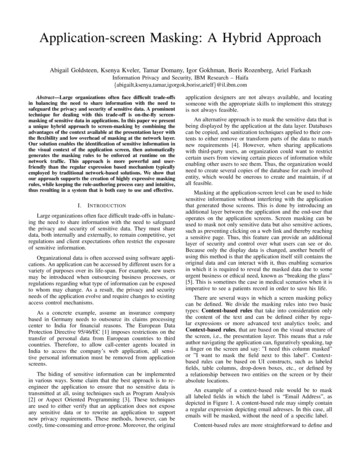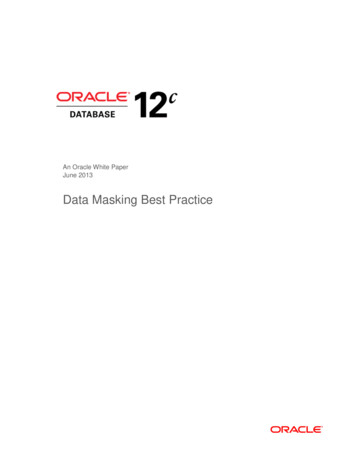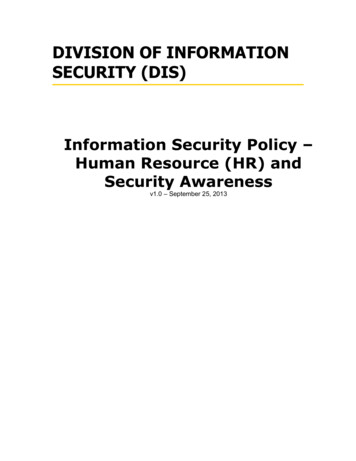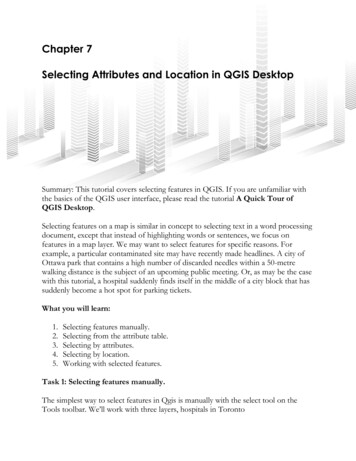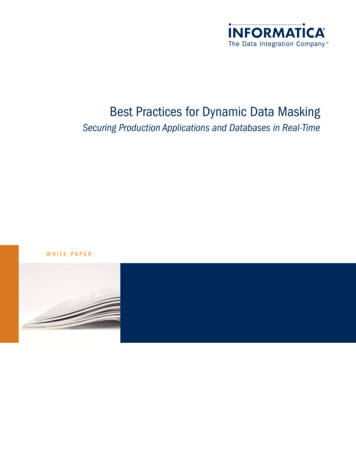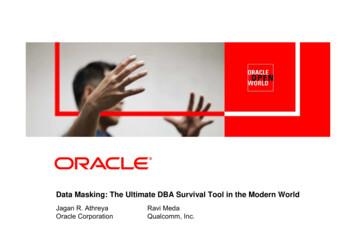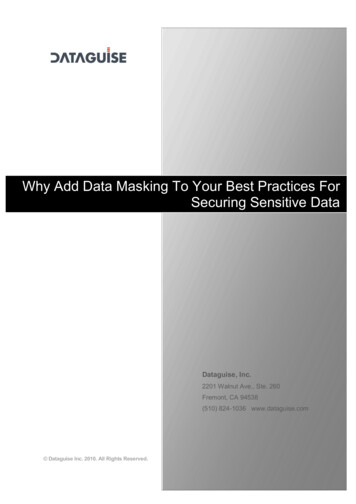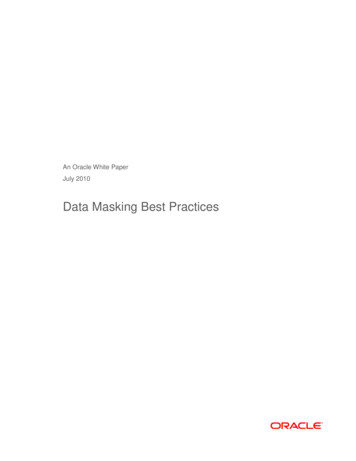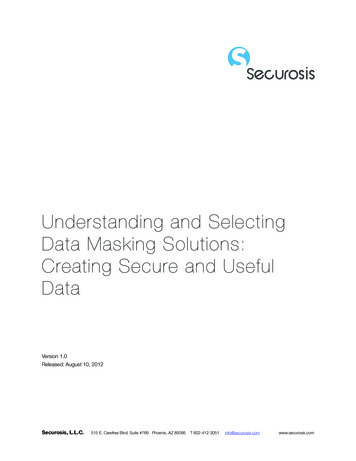
Transcription
Understanding and SelectingData Masking Solutions:Creating Secure and UsefulDataVersion 1.0Released: August 10, 2012Securosis, L.L.C.515 E. Carefree Blvd. Suite #766 Phoenix, AZ 85085T 602-412-3051info@securosis.comwww.securosis.com
Author’s NoteThe content in this report was developed independently of any sponsors. It is based on material originally posted on theSecurosis blog but has been enhanced, reviewed, and professionally edited.Special thanks to Chris Pepper for editing and content support, and to Rich Mogull for his Five Laws of Data Masking.Licensed by IBMIBM InfoSphere Optim and InfoSphere Guardium solutions for data security and privacyprotect diverse data types across different locations throughout the enterprise, includingthe protection of structured and unstructured data in both production and nonproduction (development, test and training) environments. Such an approach can helpfocus limited resources without added processes or increased complexity. A holisticapproach also helps organizations to demonstrate compliance without interrupting critical business processes or dailyoperations.IBM InfoSphere solutions for data security and privacy support heterogeneous enterprise environments including all majordatabases, custom applications, ERP solutions and operating platforms. IBM InfoSphere Optim and InfoSphereGuardium scale to address new computing models such as cloud and big data environments.For more information, visit: www.ibm.comLicensed by InformaticaInformatica Corporation is the leading independent provider of enterprise data integration software. Our mission is to helporganizations increase their competitive advantage by maximizingtheir return on data to drive their top business imperatives andinformation technology initiatives. Data is one of anorganization’s most strategic assets, and we continue todevelop solutions for nearly every type of enterprise, regardless of which technology platform, application, or databasecustomers choose. We address the growing challenge organizations face with data fragmented across and beyond theenterprise and with data of varying quality.Informatica solutions for data privacy address the unique challenges that IT organizations face in securing sensitive datain both production and nonproduction environments. Based on an innovative, open architecture, these comprehensivesolutions are highly flexible and scalable, and provide for real-time or batch processing – dynamic or persistent. Witheasy, fast, and transparent deployment, plus a centralized management platform, Informatica solutions for data privacywill help your organization to protect and control access to your transactional and analytic data, reduce compliance,development and testing costs, and ensure data privacy.For more information, visit: www.informatica.comSecurosis, L.L.C.http://securosis.com
Securosis, L.L.C.Licensed by MENTIS SoftwareMENTIS Software is the data masking and sensitivedata discovery company. A comprehensive platformhelps organizations with security for their enterprisedatabases and applications, whether managed onpremise or in cloud deployments.MENTIS’ Sensitive Data Discovery capabilities enable repeatable scanning and classification of sensitive data toprovide enterprise-wide visibility to potential exposures of sensitive data. Companies benefit by lowering the risk of adata breach while managing the cost of compliance.MENTIS protects both production and non-production environments with rapid deployment of static masking, dynamicmasking, audit reporting and user access monitoring.MENTIS has received numerous awards for its technology and leadership in the marketplace and has many customersacross the globe, in many different industries, who are benefiting from the company’s leading-edge solutions.For more information, visit: mentisoftware.comCopyrightThis report is licensed under Creative Commons Attribution-Noncommercial-No Derivative Works .0/us/Name of report2
Table of ContentsIntroduction2Use Cases3Defining Data Masking6Data Masking DefinitionFive Laws of Data MaskingMasksMasking ConstraintsHow Masking WorksDeployment ModelsData SourcesTechnical ArchitectureBase ArchitectureDeployment and Endpoint OptionsPlatform ManagementCentral Management66781111151717182020Advanced Features22Buyer’s Guide24Conclusion28About the Author29About Securosis30Securosis – Understanding and Selecting Data Masking Solutions
IntroductionVery few data security technologies can simultaneously protect data while preserving its usefulness. Data is valuablebecause we use it to support business functions — its value is in use. The more places we can leverage data to makedecisions the more valuable it is. But as we have seen over the last decade, data propagation carries serious risks. Creditcard numbers, personal information, health care data, and good old-fashioned intellectual property are targets forattackers who steal and profit from other people’s information. To lessen the likelihood of theft, and reduce risks to thebusiness, it’s important to eliminate both unwanted access and unnecessary copies of sensitive data. The challenge ishow to accomplish these goals without disrupting business processes and applications.Data masking technology provides data security by replacing sensitive information with a non-sensitive proxy, but doingso in such a way that the copy of data that looks -- and acts -- like the original. This means non-sensitive data can beused in business processes without changing the supporting applications or data storage facilities. You remove the riskwithout breaking the business! In the most common use case, masking limits the propagation of sensitive data within ITsystems by distributing surrogate data sets for testing and analysis. In other cases, masking will dynamically providemasked content if a users request for sensitive information is deemed ‘risky’. Masking architectures are designed to fitwithin existing data management frameworks and mitigate risks to information without sacrificing usefulness. Maskingplatforms act as a data Shepard, locating data, identify risks and applying protection as information moves in and out ofthe applications that implement business processes.Data masking has been around for years but the technology has matured considerably beyond its simple script-basedbeginnings, most recently advancing rapidly to address customer demand for solutions to protect data and comply withregulations. Organizations tend to scatter sensitive data throughout their applications, databases, documents andservers to enable employees to perform their jobs better and faster. Sensitive data sets are appearing and expandingever more rapidly. Between worsening threats to that data, and regulatory mandates to ‘incentivize’ customers into takingdata security seriously, the masking market has ballooned in recent years — fourfold in the last three years by ourestimates. Much of this has been driven by the continuing need to derive information from a sea of data while addressincreasing compliance requirements. Of all the technologies available to reconcile these conflicting imperatives, maskingoffers several unique advantages.In this paper, Understanding and Selecting Data Masking Solutions, we will discuss why customers buy maskingproducts, how the technology works, and what to look for when selecting a masking platform. As with all Securosisresearch papers, our goal is to help end users get their jobs done. So we will focus on how to help you, would-bebuyers, understand what to look for in a product. We will cover use cases at a fairly high level, but we’ll also dig into thetechnology, deployment models, data flow, and management capabilities, to assist more technical buyers understandwhat capabilities to look for. At the end of this paper we provide a brief guide to features to look for, based on the mostcommon use cases and deployment preferences.Securosis – Understanding and Selecting Data Masking Solutions2
Use CasesOver the last decade we have consistently heard about three use cases behind the bulk of purchases:Test Data Creation and ManagementThis is, by far, the most important reason customers gave for purchasing masking products. When polled, mostcustomers say their #1 use for masking technologies is to produce test and analysis data. They want to make sureemployees don’t do something stupid with corporate data, like making private data sets public, or moving productiondata to unsecured test environments. This informal description is technically true as far as customer intent, but fails tocapture the essence of what customers look for in masking products. In actuality, masking data for testing and sharing isalmost a trivial subset of the full customer requirement; tactical production of test data is just a feature. The real need isfor administrative control of the entire data security lifecycle — including locating, moving, managing, and masking data.The mature version of today’s simpler use case is a set of enterprise data management capabilities which control the flowof data to and from hundreds of different databases. This capability answers many of the most basic security questionswe hear customers ask, such as “Where is my sensitive data?” “Who is using it?” and “How can we effectively reducethe risks to that information?”Companies understand that good data makes employees’ jobs easier. And employees are highly motivated to procuredata to help do their jobs, even if it’s against the rules. If salespeople can get the entire customer database to help meettheir quotas, or quality assurance personnel think they need production data to test web applications, they usually findways to get it. The same goes for decentralized organizations where regional offices need to be self-sufficient, andorganizations needing to share data with partners. The mental shift we see in enterprise environments is to stop fightingthese internal user requirements, and instead find a safe way to satisfy the demand. In some cases this meansautomated production of test data on a regular schedule, or self-service interfaces to produce masked content ondemand. Such platforms are effectively implementing a data security strategy for fast and efficient production of testdata.ComplianceCompliance is the second major driver cited by customers for masking product purchases. Unlike most of today’semerging security technologies, it’s not just the Payment Card Industry’s Data Security Standard (PCI-DSS) driving sales— many different regulatory controls, across various industry verticals, are creating broad interest in masking. Earlycustomers came specifically from finance — but adoption is well distributed across different segments — with strongadoption across retail, telecomm, health care, energy, education, and government. The diversity of customerrequirements makes it difficult to pinpoint any one regulatory concern that stands out from the rest. During discussionswe hear about all the usual suspects — including PCI, NERC, GLBA, FERPA, HIPAA, Mass 201 CMR 17, and in someSecurosis – Understanding and Selecting Data Masking Solutions3
cases multiple requirements at the same time. These days we hear about masking being deployed as a more genericcontrol — customers cite protection of Personally Identifiable Information (PII), health records, and general customerrecords, among other concerns — but we no longer see every customer focused on one specific regulation orrequirement. Now masking is perceived as addressing a general need to avoid unwanted data access, or to reduceexposure as part of an overall compliance posture. It’s attractive across the board because it removes sensitive data andthus eliminates risk of data sets being scattered across the organization.For compliance, masking is used to protect data with minimal modification to systems or processes which use the nowmasked data. Masking provides consistent coverage across files and databases with very little adjustment to existingsystems. Many customers layer masking and encryption together — using encryption to secure data at rest and maskingto secure data in use. Customers find masking better at maintaining relationships within databases; they also appreciatethat it can be applied dynamically, causing fewer application side effects. Several customers note that masking hassupplanted encryption as their principal control, while others are using the two technologies to support each another. Insome cases encryption is deployed as part of the infrastructure (intrinsic to SSL, or embedded in SAN), while othersemploy encryption as part of the data masking process — particularly to satisfy regulations that prescribe encryption. Inessence encryption and even tokenization are add-ons to their masking product. But the difference worth noting is thatmasking provides data lifecycle management -- from discovery to archival -- whereas encryption is applied in a morefocused manner, often independently at multiple different points, to address specific risks. The masking platformmanages the compliance controls, including which columns of data are to be protected, how they are protected, andwhere the data resides.Production Database ProtectionThe first two use cases drive the vast majority of market demand for masking. While replacement of sensitive data —specifically through ETL style deployments — is by far the most common, it is not the only way to protect data in adatabase. For some firms protection of the production database is the main purpose of masking, with test datasecondary. But production data generally cannot be removed as it’s what business applications rely upon, so it needs tobe protected in place. There are many ways to do this, but newer masking variants provide a means of leveragingproduction applications to provide secured data.This use case centers around protecting information with fine control over user access, with a dynamic determination ofwhether or not to provide access — something user roles and credentials for files or databases -- are not designed tosupport. To accomplish this, requests for information are analyzed against a set of constraints such as user identity,calling application, location, time of day and so on. If the request does not meet established business use cases, the usergets the masked copy of the data. The masking products either alter a user requests for data to exclude sensitiveinformation, or modify the data stream before it’s sent back to the user.Keep in mind this type of deployment model is used when a business wants to leverage production systems to provideinformation access, without altering business systems to provide the finer grained controls or embedding additionalaccess and identity management systems. Dynamic and proxy based masking products supplement existing databasesystems, eliminating the need for expensive software development or potentially destabilizing alterations. ETL may be themost common model, but dynamic masking is where we witness the most growth. Customers appreciate the ability todynamically detect misuse while protecting data; this ability to monitor usage and log events helps detect misuse and themask ensures copies of data are not provided to suspect users.Securosis – Understanding and Selecting Data Masking Solutions4
Emerging Use CasesIt is worth mentioning a few other upcoming use cases. We have not seen customer adoption of the following use cases,the majority of customers we interviewed were actively investigating the following options.One model that has gotten considerable attention over the last year couple years is masking data for ‘the cloud’, orpushing data into multi-tenant environments. The reasons behind customer interest in the cloud varied, but leveragingcost-effective on demand resources or simple an easier was to share data with customers or partners without openingholes into in-house IT systems. It was common amongst those surveyed to include traditional relational databases, datawarehouse applications, or even NoSQL style platforms like Hadoop. When asked about this, several companiescomplained that the common security strategy of “walling off” data warehouses through network segmentation, firewalls,and access control systems, worked well for in-house systems but was unsuitable for data ‘outside governancecontrols’. These customers are looking for better ways to secure data instead of relying on infrastructure and (old)topology. Research into masking to enforce policy in multi-tenant environments was atop customer interest.We were surprised by one use case: masking to secure streams of data — specifically digitized call records or XMLstreams of — which came up a number of times, but not enough yet to constitute a trend. Finally, we expected far morecustomers to mention HIPAA as a core requirement in order to mask in order to secure complex data sets. Only one firmcitied HIPAA driving masking. While dozens of firms mentioned patient health records as a strong area of interest, it’s notyet driving sales.Securosis – Understanding and Selecting Data Masking Solutions5
Defining Data Masking‘Masking’ has become a ‘catch-all’ phrase used to describe masks, the process of masking, and a generic description ofdifferent obfuscation techniques such as tokenization or hashing. We will offer a narrower definition of masking, but first,a couple basic terms with their traditional definitions: Mask: Similar to the traditional definition, meaning a facade or a method of concealment, a data mask is a functionthat transforms data into something new but similar. Masks must conceal the original data and should not bereversible. Masking: The conversion of data into a masked form — typically sensitive data into non-sensitive data of the sametype and format. Obfuscation: Hiding the original value of data.Data Masking DefinitionAll data masking platforms replace data elements with similar values, optionally moving masked data to a new location.Masking creates a proxy data substitute which retains part of the value of the original. The point is to provide data thatlooks and acts like the original data, but which lacks sensitivity and doesn’t pose a risk of exposure, enabling use ofreduced security controls for masked data repositories. This in turn reduces the scope and complexity of IT securityefforts. Masking must work with common data repositories, such as files and databases, without breaking the repository.The mask should make it impossible or impractical to reverse engineer masked values back to the original data withoutspecial additional information, such as a shared secret or encryption key.Five Laws of Data Masking1.Masking must not be reversible. However you mask yourdata, it should never be possible to use it to retrieve the2.original sensitive data.The five laws help captureThe results must be representative of the source data. Thethe essence of datareason to mask data instead of just generating random datais to provide non-sensitive information that still resemblesmasking, and how it helpsproduction data for development and testing purposes. Thisaddress security andcould include geographic distributions, credit cardcompliance.distributions (perhaps leaving the first 4 numbersunchanged, but scrambling the rest), or maintaining humanreadability of (fake) names and addresses.3.Referential integrity must be maintained. Masking solutionsmust not disrupt referential integrity — if a credit card number is a primary key, and scrambled as part of masking,then all instances of that number linked through key pairs must be scrambled identically.Securosis – Understanding and Selecting Data Masking Solutions6
4.Only mask non-sensitive data if it can be used to recreate sensitive data. It isn’t necessary to mask everything inyour database, just those parts that you deem sensitive. But some non-sensitive data can be used to either recreateor tie back to sensitive data. For example, if you scramble a medical ID but the treatment codes for a record couldonly map back to one record, you also need to scramble those codes. This attack is called inference analysis, andyour masking solution should protect against it.5.Masking must be a repeatable process. One-off masking is not only nearly impossible to maintain, but it’s fairlyineffective. Development and test data need to represent constantly changing production data as closely aspossible. Analytical data may need to be generated daily or even hourly. If masking isn’t an automated process it’sinefficient, expensive, and ineffective.The following graphic illustrates a typical masking process. We select data from a file or database, mask the sensitivedata, and then either update the original file/database, or store the masked data to a new location.Masks‘Masking' is a generic term which encompasses several process variations. In a broad sense data masking — just‘masking’ for the remainder of this paper — encompasses the collection of data, obfuscation of data, storage of data,and often movement of the masked information. But ‘mask’ is also used in reference to the masking operation itself; it’show we change the original data into something else. There are many different ways to obfuscate data depending on itstype, each embodied by a different function, and each suitable for different use cases. It might be helpful to think ofmasking in terms of Halloween masks: the level of complexity and degree of concealment both vary, depending on theeffect desired by the wearer.The following is a list of common data masks used to obfuscate data. These are the standard options masking productsoffer, with the particular value of each option: Substitution: Substitution is simply replacing one value with another. For example, the mask might substitute aperson’s first and last names with names from a random phone book entry. The resulting data still constitutes a name,but has no logical relationship with the original real name unless you have access to the original substitution table.Securosis – Understanding and Selecting Data Masking Solutions7
Redaction/Nulling: This substitution simply replaces sensitive data with a generic value, such as ‘X’. For example, wecould replace a phone number with “(XXX)XXX-XXXX”, or a Social Security Number (SSN) with XXX-XX-XXXX. This isthe simplest and fastest form of masking, but the output provides little or no value. Shuffling: Shuffling is a method of randomizing existing values vertically across a data set. For example, shufflingindividual values in a salary column from a table of employee data would make the table useless for learning what anyparticular employee earns without changing aggregate or average values for the table. Shuffling is a commonrandomization technique for disassociating sensitive data relationships (e.g., Bob makes X per year) while preservingaggregate values. Blurring: Taking an existing value and alter it so that the value falls randomly within a defined range. Averaging: Averaging is an obfuscation technique where individual numbers are replaced by a random value, butacross the entire field, the average of these values remains consistent. In our salary example above, we couldsubstitute individual salaries with the average across a group or corporate division to hide individual salary values whileretaining an aggregate relationship to the real data. De-identification: A generic term for to any process that strips identifying information, such as who produced thedata set, or personal identities within the data set. De-identification is important for dealing with complex, multi-columndata sets that provide sufficient clues to reverse engineer masked data back into individual identities. Tokenization: Tokenization is substitution of data elements with random placeholder values, although vendorsoveruse the term ‘tokenization’ for a variety of other techniques. Tokens are non-reversible because the token bears nological relationship to the original value. Format Preserving Encryption: Encryption is the process of transforming data into an unreadable state. Unlike theother methods listed, the original value can be determined from the encrypted value, but can only be reversed withspecial knowledge (the key). While most encryption algorithms produce strings of arbitrary length, format preservingencryption transforms the data into an unreadable state while retaining the format (overall appearance) of the originalvalues. Technically encryption violates the first law of data masking, but some customers we interviewed useencryption and masking side-by-side, we wanted to capture this variation.Masking ConstraintsEach type of mask excels in some use cases, offering concealment of the original while preserving some critical value oraspect of the original. Each incurs a certain amount of computational overhead. For example, it’s much easier to replacea phone number with a series of ‘X’s than it is to encrypt it. In general, applying masks (running data through a maskingfunction) is straightforward. However, various constraints make generating quality data masks much more complicatedthan it might seem at first glance. Retention of some original value makes things much more difficult and requiresconsiderable intelligence from masking products. The data often originates from, or is inserted into, a relational database;so care is required with format and data types, and to ensure that the mask output satisfies integrity checks. Typicalcustomer constraints include:Securosis – Understanding and Selecting Data Masking Solutions8
Format Preservation: The mask must produce data withMasking data is easy.the same structure as the original data. This means that if theoriginal data is 2-30 characters long, the mask shouldPreserving value andproduce data 2-30 characters long. A common example ismaintaining integrity whileday, month, and year, likely in a particular text format. Thisdates, which must produce numbers in the correct ranges forprotecting data is difficult;means a masking algorithm must identify the ‘meaning’ ofyou must verify that masks“03.31.2012”, and generate a suitable date in the samesource data such as “31.03.2012”, “March 31, 2012”, andprovide security andformat.maintain value. Data Type Preservation: With relational data storage it isessential to maintain data types when masking data from onedatabase to another. Relational databases require formaldefinition of data columns and do not tolerate text in numberor date fields. In most cases format-preserving masks implicitly preserve data type, but that is not always the case. Incertain cases data can be ‘cast’ from a specific data type into a generic data type (e.g., varchar), but it is essential toverify consistency. Gender preservation: When substituting names, male names are only substituted with other male names, andsimilarly female with only female names. This is of special importance amongst some cultures. Semantic Integrity: Databases often place additional constraints on data they contain such as a LUHN check forcredit card numbers, or a maximum value on employee salaries. In this way you ensure both the format and data typeintegrity, but the stored value makes sense in a business context as well. Referential Integrity: An attribute in one table or file may refer to another element in a different table or file, in whichcase the reference must be consistently maintained. The reference augments or modifies the meaning of eachelement, and is in fact part of the value of the data. Relational databases optimize data storage by allowing one set ofdata elements to ‘relate’, or refer, to another. Shuffling or substituting key data values can destroy these references(relationships). Masking technologies must maintain referential integrity when data is moved between relationaldatabases, or cascading values from one table to another. This ensures that loading the new data works withouterrors, and avoids breaking applications which rely on these relationships. Aggregate Value: The total and average values of a masked column of data should be retained, either closely orprecisely. Frequency Distribution: In some cases users require random frequency distribution, while in others logical groupingsof values must be maintained or the masked data is not usable. For example, if the original data describes geographiclocations of cancer patients by zip code, random zip codes would discard valuable geographical information. Theability to mask data while maintaining certain types of patterns is critical for maintaining the value of masked data foranalytics. Uniqueness: Masked values must be unique. As an example, duplicate SSNs are not allowed when uniqueness is arequired integrity constraint. This is critical for referential integrity, as the columns used to link tables must containunique values.Securosis – Understanding and Selecting Data Masking Solutions9
There are many other constraints, but these are the principal integrity considerations when masking data. Most vendorsinclude masking functions for all the types described above in the base product, with the ability to specify different dataintegrity options for each use of a mask. And most include built-in bundles of appropriate masks for regulatoryrequirements to streamline compliance. We will go into more detail when we get to use cases and compliance.Securosis – Understanding and Selecting Data Masking Solutions10
How Masking WorksIn this section we will describe how masking works, focusing on data movement and manipulation. We’ll start bydescribing the different masking models, how data flows through various topologies, and advantages and disadvantagesof each. Then we will illustrate movement of data between different sources and destinations to explain orchestrationmanaged by the masking platform an
Informatica solutions for data privacy address the unique challenges that IT organizations face in securing sensitive data in both production and nonproduction environments. Based on an innovative, open architecture, these comprehensive . Data masking technology provides data security by replacing sensitive information with a non-sensitive .
